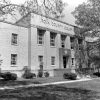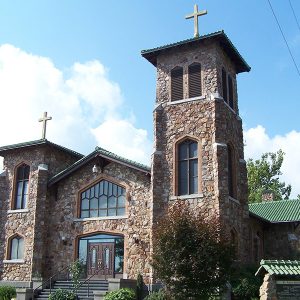calsfoundation@cals.org
St. Agnes Catholic Church
St. Agnes Catholic Church in Mena (Polk County) is the center of worship for St. Agnes Parish, which was established by Bishop Edward Fitzgerald in 1896. A temporary wooden structure first served the congregation, with a two-story frame building following. A new church building was completed in 1922, and St. Agnes Catholic Church was listed on the National Register of Historic Places in 1991, having retained all of its significant architectural and decorative features.
Mena was incorporated as a township on September 18, 1896, as settlers began to flood into the area around the Kansas City Southern rail line. Within a month of Mena’s incorporation, Bishop Fitzgerald established the parish, and with the help of Father Patrick Enright of Fayetteville (Washington County), he selected a site for the church. The first pastor, Father P. J. McCormack, came to the parish soon after and helped erect a 26′ x 40′ wooden structure that served as the initial church. It was only meant to be a temporary church until the community could grow. In 1897, the Sisters of Mercy from St. Anne’s Convent in Fort Smith (Sebastian County) helped establish the parish’s parochial school, St. Joseph’s Academy—a two-story frame building. Bishop Fitzgerald appointed Father Augustus P. Gallagher as parish priest in October 1897, only four months after he was ordained. Although Mena was his base church, Gallagher was also responsible for a mission area that spanned 10,000 square miles in western Arkansas. Despite the heavy workload, he would go on to serve the parish for more than fifty years and have a heavy influence in establishing the church building that is in use in the twenty-first century.
The original location of the first building was susceptible to flooding, so in 1910 the church, school, and rectory were moved to the site of the present-day building at the corner of 8th and Walnut streets. By that time, the parish had paid its debt on the original church building and prospered throughout 1911 as it added many new parishioners. In 1912, Gallagher made an addition to the small boxy building in order to serve his growing congregation. More additions were made to this “temporary” structure throughout the decade. The parish suffered a major setback in 1913 as the wooden school building burned during school hours. All teachers and students escaped, but it was estimated to have cost the parish around $7,500, with insurance only covering $2,500. Regardless, construction of a two-story brick schoolhouse began in October 1913 and was completed by April 1914, when it was dedicated.
The first church building had been in a dilapidated state for years despite attempts to improve it, so by 1921 Rev. Gallagher and his congregation were ready to build a new church. Gallagher had already made his own intricate plans for the building. He wanted to give it a naturalistic character by using local, unhewn stone. It seems that the primary plans for the building were those conceived by Gallagher himself, as no mention is made of an official architect. In any case, Gallagher was determined to have a lasting structure for the parish despite an estimated cost of around $15,000, a hefty amount for the small parish. Ground was broken for the new church on October 6, 1921, after Bishop John Morris gave his approval of the plans. From October 24 to October 29, women of the church held a fall festival, which raised around $1,200 to be added to the building fund. Parishioners also participated in a dime drive, raising $3,100 for the building. More than 700 parishioners and friends of the parish donated the majority of the money.
Gallagher laid the cornerstone for the church on February 10, 1922, and construction began in earnest. Costs rose during construction, ultimately totaling around $25,000 with interior decorations and furnishings. However, the parish accrued a debt of only around $5,000 by the time the church was finished in fall of 1922. The church was built in the Spanish Mission style and was plotted in the shape of a cross. The walls were faced with native boulders gathered from the area and placed by local masons Fred Warren and N. W. Swift. The stone walls were paired with pale-green, arch-ribbed roof tiles. This new St. Agnes church was dedicated on October 16, 1922—twenty-five years to the day since Father Gallagher’s appointment to the parish. In his remaining years at the parish, Gallagher often referred to the building as “The Pride of Mena.”
The former church building was relocated on the parish property, repurposed, and eventually removed. St. Joseph’s Academy remained in operation for decades after the church was built, but the school was gone by 1980. That year, a new recreational center was built where St. Joseph’s once stood. St. Agnes Catholic Church was listed on the National Register of Historic Places on June 5, 1991, having retained all of its significant architectural and decorative features. In 2009, an EF3 tornado touched down near St. Agnes in the middle of a Thursday Mass, driving around eighty parishioners to the basement. Many of the windows blew out, but the overall structure remained intact. This building continues to serve as the parish’s center of worship in the twenty-first century and provides a tangible link to the early development of the parish.
For additional information:
Arkansas Catholic Newspaper Archive. http://arc.stparchive.com/index.php (accessed September 10, 2018).
Little, Tara. “After Tornado in Mena on Holy Thursday, Parishioners Find Hope.” Arkansas Catholic, April 18, 2009. Online at https://www.arkansas-catholic.org/news/article/1703/After-tornado-in-Mena-on-Holy-Thursday-parishioners-find-hope (accessed September 10, 2018).
Souvenir of the Dedication of St. Agnes New Church, October 16, 1922. Mena, AR: Star Printing, 1922. Butler Center for Arkansas Studies. Central Arkansas Library System, Little Rock, Arkansas.
Souvenir of the Golden Sacerdotal Jubilee of The Rt. Rev. Msgr. A.P. Gallagher, V.F., Ordained June 19, 1897. Online at http://www.stagneschurchmena.org/Fifty%20Golden%20Years.pdf (accessed September 10, 2018).
St. Agnes Catholic Church. http://www.stagneschurchmena.org/history.html (accessed September 10, 2018).
“St. Agnes Catholic Church.” National Register of Historic Places registration form. On file at Arkansas Historic Preservation Program, Little Rock, Arkansas. Online at http://www.arkansaspreservation.com/National-Register-Listings/PDF/PL0106.nr.pdf (accessed September 10, 2018).
“St. Agnes Church, 1896–1991.” Mountain Signal, August 1998, pp. 15–16, 30–31.
David Collins
Arkansas Historic Preservation Program
 Early Twentieth Century, 1901 through 1940
Early Twentieth Century, 1901 through 1940 Historic Preservation
Historic Preservation Polk County
Polk County Roman Catholics
Roman Catholics St. Agnes Catholic Church
St. Agnes Catholic Church 




Comments
No comments on this entry yet.